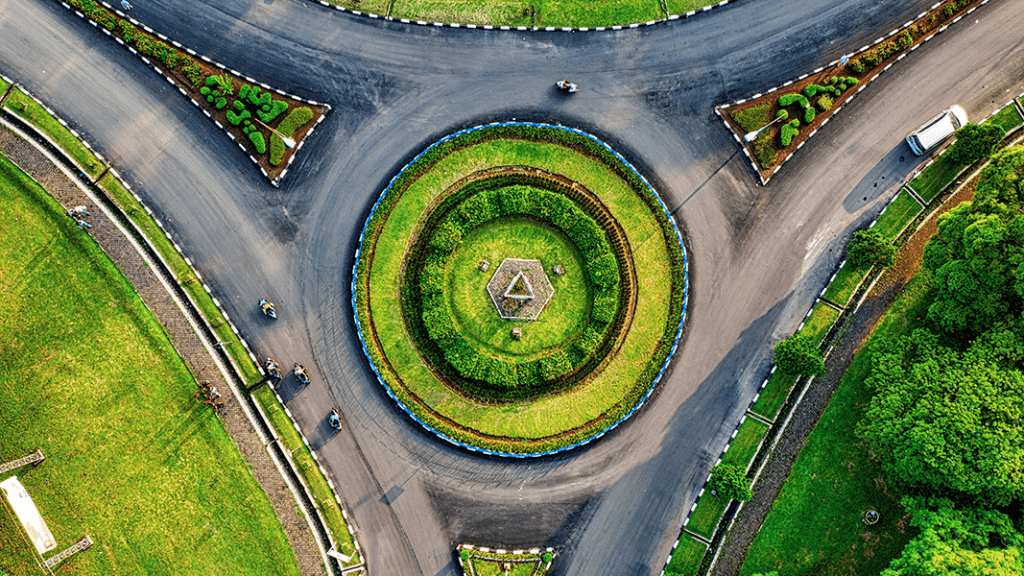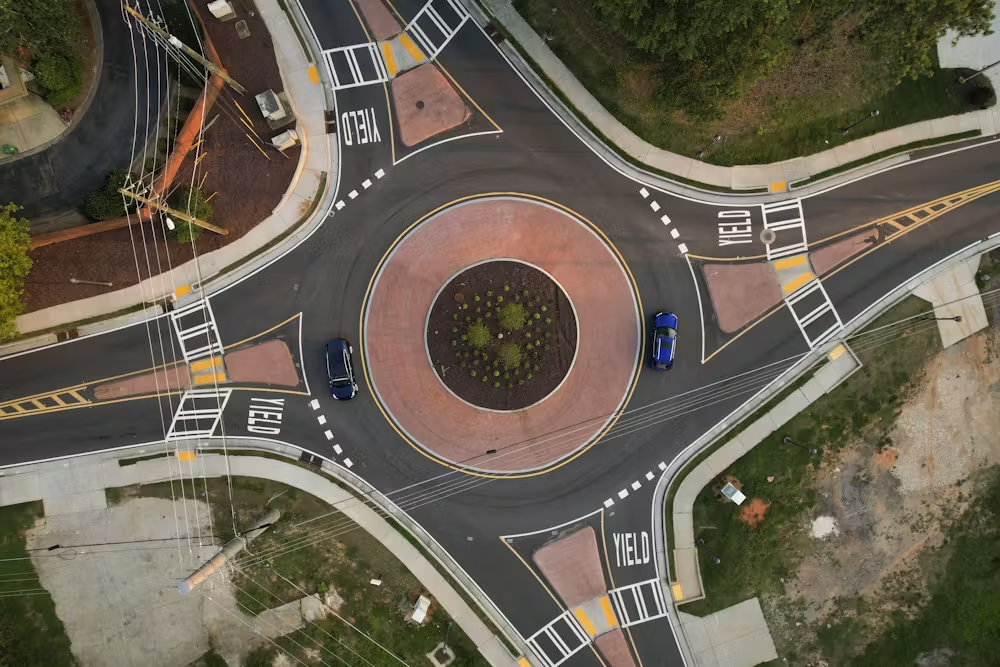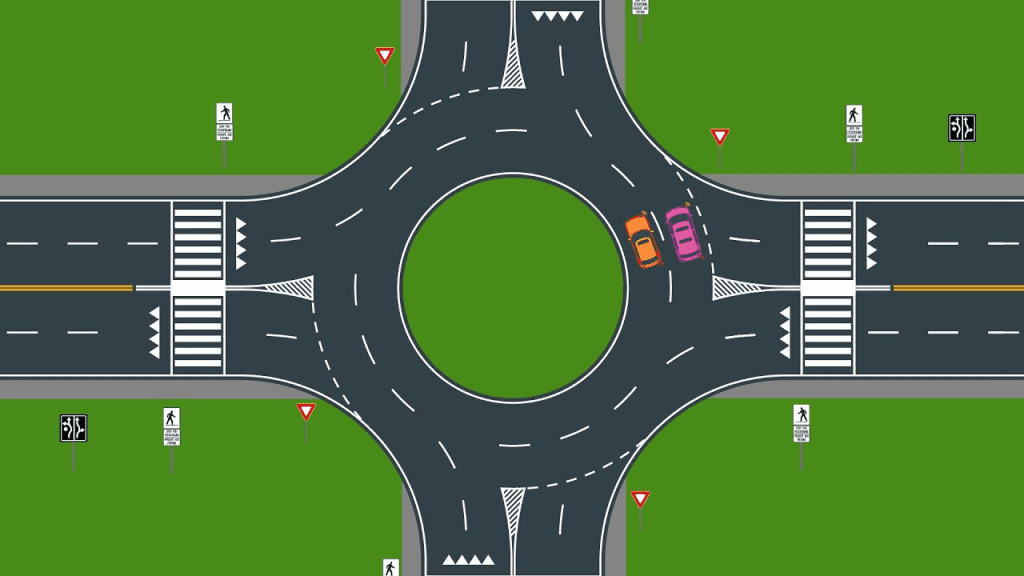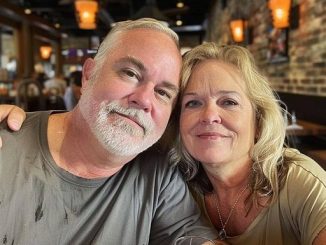If you’ve been driving through U.S. cities and towns, you’ve likely noticed an increase in roundabouts replacing traditional four-way intersections. Some drivers embrace them as an efficient traffic solution, while others find them confusing or even intimidating.
But what exactly is a roundabout, and why is it becoming a preferred alternative to stop signs and traffic signals? Roundabouts are not just about traffic flow—they are a safer, more efficient, and environmentally friendly way to design roads.
Let’s break down what roundabouts are, how they work, and why they are considered one of the most effective traffic management solutions today.
What is a Roundabout? Understanding the Basics

A roundabout—also known as a rotary or traffic circle—is a circular intersection where vehicles move counterclockwise around a central island. Unlike traditional intersections controlled by stop signs or traffic lights, roundabouts operate using a yield-at-entry system, meaning:
✔ Drivers entering the roundabout must yield to vehicles already circulating.
✔ Traffic flows continuously, reducing congestion and unnecessary stops.
✔ Speeds are naturally reduced, leading to safer driving conditions.
Most roundabouts also include:
🔹 Splitter islands – Raised medians that help slow down traffic before entering.
🔹 Pedestrian crosswalks – Positioned away from the central island to increase safety.
🔹 Lane markings – Clear indicators help guide drivers into the correct exit lane.
The result? A smoother, safer, and more efficient intersection that reduces both traffic delays and accidents.
A Brief History of Roundabouts
Many people assume roundabouts are a modern innovation, but their history dates back hundreds of years.
Video : Roundabout Safety Benefits
- 1700s – Early versions of circular intersections appeared in Europe, particularly in England and France.
- 1800s-1900s – Washington, D.C. was designed with multiple traffic circles, inspired by European models.
- 1950s – The United Kingdom introduced the yield-at-entry rule, transforming roundabouts into the efficient system we use today.
- 1990s – The first modern roundabout in the U.S. was built in Summerlin, Nevada in 1990.
- Today – Over 10,000 roundabouts exist in the United States, with more being installed every year.
While roundabouts have been common in Europe and Australia for decades, the U.S. is now rapidly adopting them due to their proven safety and efficiency benefits.
Why Roundabouts Are Safer Than Traditional Intersections
One of the biggest reasons cities are replacing traditional intersections with roundabouts is safety.
1. Fewer Conflict Points = Fewer Accidents
A typical four-way intersection has 32 conflict points—areas where vehicle paths cross, increasing the risk of collisions. In contrast, a roundabout reduces conflict points to just 8.
This means:
✔ No head-on collisions
✔ No dangerous T-bone crashes
✔ Fewer high-speed impacts
According to the Federal Highway Administration (FHWA), roundabouts can reduce serious and fatal crashes by up to 90% when replacing a stop-controlled intersection. Even when replacing a traffic signal intersection, they reduce serious crashes by nearly 80%.
2. Lower Speeds = Less Severe Collisions
In a roundabout, vehicles enter and exit at lower speeds (15-25 mph), compared to the higher speeds (40-50 mph) seen at traditional intersections.
Lower speeds lead to:
✔ Less severe crashes
✔ Fewer pedestrian injuries
✔ Easier decision-making for drivers
3. Safer for Pedestrians and Cyclists

Roundabouts offer better protection for pedestrians because:
✔ Crosswalks are set back from the circular flow, allowing drivers to see pedestrians clearly.
✔ Pedestrians only cross one direction of traffic at a time, making crossings safer.
✔ Cyclists can either merge into traffic or use a designated bike path, depending on the design.
With these safety features, roundabouts significantly reduce pedestrian-related accidents compared to traditional intersections.
Efficiency: Why Roundabouts Improve Traffic Flow
Beyond safety, roundabouts are also more efficient than stop signs or traffic lights.
1. Less Waiting, More Moving
At a traditional intersection, cars must stop at red lights, even when there’s no cross traffic. In a roundabout:
✔ Traffic keeps moving – No unnecessary stops.
✔ Fewer backups – No long wait times during rush hour.
✔ Reduced driver frustration – No more waiting for a green light when there’s no oncoming traffic.
2. Eliminating Left Turns = Smoother Flow
One of the most dangerous and disruptive movements at an intersection is the left turn. Roundabouts eliminate left turns, forcing all vehicles to move in the same direction, improving:
✔ Traffic efficiency – No waiting for gaps in oncoming traffic.
✔ Driver decision-making – No confusion about when to turn.
3. Roundabouts Handle High Traffic Volumes Better
Unlike stop signs and traffic lights, which cause congestion during peak hours, roundabouts allow continuous movement, making them ideal for high-traffic areas.
Environmental Benefits: How Roundabouts Help the Planet

Roundabouts aren’t just safer and more efficient—they also have environmental advantages.
1. Reduced Fuel Consumption
✔ Less idling at red lights = less wasted fuel
✔ Lower speeds = better fuel efficiency
According to studies, roundabouts can reduce fuel consumption by up to 30%, making them a cost-effective solution for drivers.
2. Lower Carbon Emissions
Fewer stops and starts mean lower emissions, helping reduce air pollution in urban areas. Cities that replace signalized intersections with roundabouts see:
✔ Less smog and pollution
✔ Improved air quality
3. Less Road Maintenance Required
✔ No traffic signals = lower maintenance costs
✔ Roundabouts last longer than traffic lights
With less infrastructure to maintain, roundabouts save cities money in the long run.
Challenges: Why Some Drivers Struggle with Roundabouts
Despite their many benefits, some drivers remain hesitant about roundabouts. Common challenges include:
🚦 Confusion about yielding – Some drivers don’t understand that they must yield to circulating traffic before entering.
🚦 Merging issues – Drivers unfamiliar with roundabouts sometimes hesitate, causing unnecessary slowdowns.
🚦 Exit mistakes – Some drivers find it difficult to choose the correct exit and miss their turn.
However, studies show that once drivers become familiar with roundabouts, their confidence improves significantly.
Video : Principles of Intersection Safety
Final Thoughts: Are Roundabouts the Future of Road Design?
Roundabouts are more than just a traffic trend—they are a safer, smarter, and greener solution for modern transportation. With their ability to reduce crashes, improve traffic flow, and lower emissions, they are quickly becoming a preferred alternative to traditional intersections.
🚗 Safer roads, fewer accidents
🚗 Smoother traffic, less congestion
🚗 Lower fuel costs, reduced pollution
As more states adopt roundabouts in urban and suburban planning, they will likely become a permanent feature of America’s roadways.
So next time you approach a roundabout, embrace the change—it’s making our roads safer and more efficient for everyone!
This actor went from $150 a month to running a farm with his famous wife

Can you guess the iconic actor who went from living in a rundown New York “flophouse” for just $150 a month to owning a peaceful farm with his family?
This actor’s humble beginnings are a far cry from his current life of farm animals and fresh home-grown veggies. Growing up, he knew from an early age that he wanted to be an actor.
After trips to the movie theater, he would come home and immediately dress up as one of the characters from the film, fully immersing himself in the world of make-believe. His favorite childhood toy? A box of old clothes his mom had saved for him, which he used to fuel his imagination and creativity.

Wanted the ”real thing”
In 1976, fresh out of Philadelphia, he moved to New York City to chase his dream of acting. He spent months crashing on his sister’s couch before finding a cheap place through an ad in the Village Voice – a no-frills, budget-friendly “artist’s residence.”
Though the place was far from glamorous, it was exactly what he could afford at the time. In fact, the actor shared that it wasn’t even a single room – he had to move in with a roommate.
His roomie was a classical pianist, and the two shared the space for four years. In interviews, the actor fondly reminisces about the calming sounds of the piano that filled the apartment late at night.
While living in The Big Apple, the actor appeared in a production at the Circle in the Square Theater School. ”I wanted life, man, the real thing,” he later recalled to Nancy Mills of Cosmopolitan.

”The message I got was ‘The arts are it. Business is the devil’s work. Art and creative expression are next to godliness.’”
So, can you guess who this determined actor is?
He has a tall, lean frame and a signature look that’s a mix of rugged and charming.
With a square jaw and high cheekbones, he’s got a face that can go from intense to relatable in an instant. His light brown hair is often casually styled, and his deep-set eyes add a mysterious vibe. You might recognize his easy-going, yet timeless style that’s made him a fan favorite for decades. Can you guess who he is?
Alright, we won’t drag this out any longer.
While this Golden Globe Award winner was living in that tiny, $150-a-month space, he was also preparing for his big break.
Household name
Fast forward a few years, and he would go on to star in iconic films like Footloose, Beauty Shop, and The Woodsman, becoming a household name.
So here it is – it’s Kevin Bacon! From his early days as a young actor in New York to now living on a farm with his wife and their animals, his journey has truly been one to follow
Now, the actor is living a completely different life. He and his wife, fellow actress Kyra Sedgwick, now shares a 40-acre farm in Sharon, Connecticut. They have several animals, including goats, pigs, alpacas, and miniature horses.
”I love animals, they are a joy to be around, and they’re very, very calming for me,” Bacon said. ”But we also really love to go into the garden and get fresh herbs or tomatoes or basil or peppers or zucchini.”
And talk about how Bacon is living a completely different life today compared to his bachelor days in New York. He’s got more millions in the bank now – and doesn’t have to rely on his old roommate’s cooking skills anymore.
”He would cook,” Bacon said of his former roommate in New York.
”I didn’t know anything about cooking since I was used to going to the store and getting a sandwich or eating a slice of pizza.”
He added, ”And I watched my roommate, and he was a very frugal man so he was not going to go out and spend money to eat in a restaurant or even get something to go. He would make his own food and I got very inspired by that.”
Gradually, both Kevin and Kyra shares snippets of their daily lives on social media, with Sedgwick posting so many videos of her and their goats to TikTok that people now recognize her for it, rather than her acting roles.
“People were like, ’We love you singing with the goats.’ Kevin and I are like, ’Great, have you seen our movies or TV shows?’ But it makes people happy,” the actress and producer told People.
They even shared that his relationship with his animals has caused a shift in his eating habits — he no longer eats goat or pig products.
”It’s all about the animals,” Kevin says, adding that his wife won’t let him get any more animals, as he’d likely stop eating even more types of food. The couple also loves tending to their garden, growing fresh herbs, tomatoes, and peppers.
Interestingly, the Footloose star and Sedgwick aren’t the only celebs drawn to farm life. In fact, famed actress Jennifer Garner decided to buy back the farm her mother grew up on and transform it into an organic produce project for baby food.



Leave a Reply